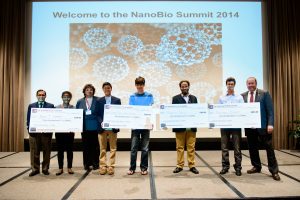
TUSCALOOSA, Ala. – Judges selected seven student presenters as winners for their research poster presentations given during a recent scientific forum on nanotechnology and biotechnology hosted by The University of Alabama.
Four undergraduate and three graduate students, representing various universities, were recognized for their work during the NanoBio Summit 2014.
“The summit brought 200 students, faculty, researchers and state and federal program officials to The University of Alabama campus,” said Dr. Carl A. Pinkert, vice president for research and economic development at UA. “Dr. Patty Sobecky and her organizing committee, representing eight Alabama universities, did a tremendous job bringing together science, engineering and technology-based expertise that clearly benefitted the many students in attendance.”
Sobecky, associate provost for academic affairs, highlighted the many opportunities for undergraduate and graduate students to network with researchers representing academia, industry and government.
“With more than 75 poster presentations this year, it was incredibly difficult to select the winners as the caliber of the research and student presentations was outstanding,” she said.
Sarah McFann, of UA’s chemical and biological engineering department, won first place in the undergraduate division. Sarah’s poster co-authors were Benjamin Ricca, Mike D’Ambrosio, Johnathan Wang and Daniel Fletcher, of the department of bioengineering at the University of California, Berkeley. The poster was titled “Automated, Tablet-Based Microscope for Imaging 3D Culture Models of Breast Epithelia Growth and Behavior.”
Undergraduate presenters from Auburn University and Alabama State University tied with an undergraduate presenter representing UA for second place.
Stephen H. Brown, of the College of Science and Mathematics at Auburn, and his co-authors Atul A. Chaudhari, Shree R. Singh and Shreekumar R. Pillai, of the Center for Nanobiotechnology Research at Alabama State, tied with Ben Binderow and Dr. Vinu Unnikrishnan, assistant professor, of UA’s aerospace engineering and mechanics department.
Brown’s poster was titled “Preteomic Studies of Antibacterial Peptides” and Binderow’s poster was titled “Multiscale Modeling of Electrical Properties of Carbon Nanotube-Based Composites.”
Third place was awarded to Marcus D. Davis, undergraduate presenter, and co-authors Saurabh Dixit, Shree R. Singh and Vida Dennis, of the Center for NanoBiotechnology Research at Alabama State University. Their poster was titled “Polyvinyl Alcohol Influences Polylactic Acid-Polethylene Glycol Copolymer Morphology and Encapsulation Efficiency Characteristics.”
In the graduate student division, judges awarded first place to Dereca Watkins who presented on behalf of co-authors Md. Nuruddin, Alfred Tcherbi-Narteh, Mahesh Hosur and Shaik Jeelani, of the department of materials science and engineering at Tuskegee University for “Synthesis and Characterization of Novel Phenolic Resin System Based on Lignin Extracted from Different Biomass Resources.”
Second place was awarded to Matthew Eggert. Matthew’s co-authors were Andrew Brannen, Robert Arnold and Peter Panizzi, of the department of drug discovery and development, Harrison School of Pharmacy, Auburn University. Their poster was titled “A Simple Method for the 360-Degree Acquisition of Bioluminescence, Fluorescence, or X-Ray Data Using a Mouse Imaging Spinner.”
Third place was awarded to Jonghwa Oh who presented a poster with co-authors Claudiu T. Lungu, of the department of environmental health sciences, the University of Alabama at Birmingham, and Evan L. Floyd, of the department of occupational and environmental health, The University of Oklahoma. The group’s poster was titled “Surface Area and Toluene Adsorption Capacity for Fabricated Single-Walled Carbon Nanotube Buckypaper.”
The forum attracted researchers from across the state and region and featured a dozen scientists from in-state and neighboring institutions as well as representatives from the Economic Development Partnership of Alabama, Southern Research Institute, the DoD Defense Advanced Research Projects Agency, the HudsonAlpha Institute for Biotechnology and elsewhere.
General areas of focus at the conference included: nanobioscience, nanoengineering, nanomaterials, nanomedicine, collaboration, discovery and commercialization.
Contact
Chris Bryant, UA media relations, 205/348-8323, cbryant@ur.ua.edu